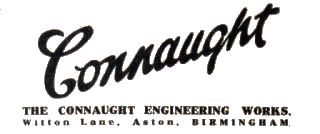

They built Connaught motorcycles from 1912 to 1926
1912 The first machine was exhibited at the Olympia Show. They had one basic model, with a 293cc petroil-lubricated two-stroke engine and Amac carburettor at the rear of the cylinder. The engine design was quite advanced and inside it had a one-piece crankshaft, a connecting rod with split big-end and a deflector piston. It also had belt drive, single speed and sprung forks.
1914 Various transmissions were available to offer one, two or three speeds and belt or chain-cum-belt
drive. There was also a ladies' version and all had the same engine. An oil receptacle, held by bayonet
joint to a tap on the oil tank, enabled the rider to draw off a measured amount to mix with the petrol.
Connaught 1914
1915-1916 The range continued for those two years and then production ceased for the remainder of the Great War.
1919 Following the armistice models were produced with single or two-speed variants plus
a Miniature which had smaller, 24-inch wheels. For the next
few years there was little change.
Connaught 1919
1922 The Miniature was dropped and a 348cc two-stroke model appeared. This had a three-speed Burman gearbox and all-chain drive.
1923 Various machines of various specifications continued to be produced,
including a complete sidecar outfit with a larger engine.
Connaught 1923
1924 The marque was bought by the J.
E. S. Motor Company and production moved to Gloucestershire for a while,
before going back to Birmingham.
Connaught 1924
1925 Change of ownership brought a change in design and they added four-strokes with a Blackburne ohv, an oil-cooled Bradshaw and a sv engine of their own make. Yet more four-strokes were added, with either Blackburne or Bradshaw engines.
1926 They now listed two models fitted with their own engine as well as several other models with Blackburne, Bradshaw JAP units. They also built a solitary two-stroke. It was their last year of production.
Warland-Blackburne was a motorcycle produced in 1923, by the Bordesley Engineering Company, of New Bond street, Birmingham.
This was a reasonably priced machine fitted with a 348cc sv Blackburne engine with three-speeds and all-chain drive, Druid side-spring forks, BTH magneto and an Amac carburettor. As these were all industry standards and available in quantity, the retail price was quite competitive.
Sources: Graces Guide, The Motor Cycle
If you have further information or a query related to this page, please contact us